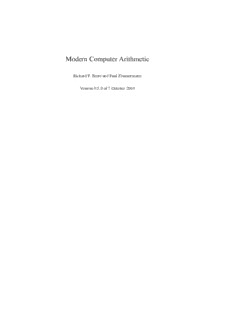Table Of ContentModern Computer Arithmetic
RichardP.BrentandPaulZimmermann
Version0.5.9of7October2010
iii
Copyright c 2003-2010RichardP.BrentandPaulZimmermann
°
Thiselectronicversionisdistributedunderthetermsandconditionsofthe
CreativeCommonslicense“Attribution-Noncommercial-NoDerivativeWorks
3.0”.Youarefreetocopy,distributeandtransmitthisbookunderthefollowing
conditions:
Attribution. You must attribute the work in the manner specified by the
•
authororlicensor(butnotinanywaythatsuggeststhattheyendorseyouor
youruseofthework).
Noncommercial.Youmaynotusethisworkforcommercialpurposes.
•
No Derivative Works. You may not alter, transform, or build upon this
•
work.
Foranyreuseordistribution,youmustmakecleartoothersthelicenseterms
ofthiswork.Thebestwaytodothisiswithalinktothewebpagebelow.Any
oftheaboveconditionscanbewaivedifyougetpermissionfromthecopyright
holder.Nothinginthislicenseimpairsorrestrictstheauthor’smoralrights.
Formoreinformationaboutthelicense,visit
http://creativecommons.org/licenses/by-nc-nd/3.0/
Contents
Contents pageiv
Preface ix
Acknowledgements xi
Notation xiii
1 Integerarithmetic 1
1.1 Representationandnotations 1
1.2 Additionandsubtraction 2
1.3 Multiplication 3
1.3.1 Naivemultiplication 4
1.3.2 Karatsuba’salgorithm 5
1.3.3 Toom–Cookmultiplication 6
1.3.4 UseofthefastFouriertransform(FFT) 8
1.3.5 Unbalancedmultiplication 8
1.3.6 Squaring 11
1.3.7 Multiplicationbyaconstant 13
1.4 Division 14
1.4.1 Naivedivision 14
1.4.2 Divisorpreconditioning 16
1.4.3 Divideandconquerdivision 18
1.4.4 Newton’smethod 21
1.4.5 Exactdivision 21
1.4.6 Onlyquotientorremainderwanted 22
1.4.7 Divisionbyasingleword 23
1.4.8 Hensel’sdivision 24
1.5 Roots 25
1.5.1 Squareroot 25
1.5.2 kthroot 27
Contents v
1.5.3 Exactroot 28
1.6 Greatestcommondivisor 29
1.6.1 NaiveGCD 29
1.6.2 ExtendedGCD 32
1.6.3 HalfbinaryGCD,divideandconquerGCD 33
1.7 Baseconversion 37
1.7.1 Quadraticalgorithms 37
1.7.2 Subquadraticalgorithms 38
1.8 Exercises 39
1.9 Notesandreferences 44
2 ModulararithmeticandtheFFT 47
2.1 Representation 47
2.1.1 Classicalrepresentation 47
2.1.2 Montgomery’sform 48
2.1.3 Residuenumbersystems 48
2.1.4 MSBvsLSBalgorithms 49
2.1.5 Linkwithpolynomials 49
2.2 Modularadditionandsubtraction 50
2.3 TheFouriertransform 50
2.3.1 Theoreticalsetting 50
2.3.2 ThefastFouriertransform 51
2.3.3 TheScho¨nhage–Strassenalgorithm 55
2.4 Modularmultiplication 58
2.4.1 Barrett’salgorithm 58
2.4.2 Montgomery’smultiplication 60
2.4.3 McLaughlin’salgorithm 63
2.4.4 Specialmoduli 65
2.5 Modulardivisionandinversion 65
2.5.1 Severalinversionsatonce 67
2.6 Modularexponentiation 68
2.6.1 Binaryexponentiation 70
2.6.2 Exponentiationwithalargerbase 70
2.6.3 Slidingwindowandredundantrepresentation 72
2.7 Chineseremaindertheorem 73
2.8 Exercises 75
2.9 Notesandreferences 77
3 Floating-pointarithmetic 79
3.1 Representation 79
3.1.1 Radixchoice 80
vi Contents
3.1.2 Exponentrange 81
3.1.3 Specialvalues 82
3.1.4 Subnormalnumbers 82
3.1.5 Encoding 83
3.1.6 Precision:local,global,operation,operand 84
3.1.7 Linktointegers 86
3.1.8 Ziv’salgorithmanderroranalysis 86
3.1.9 Rounding 87
3.1.10 Strategies 90
3.2 Addition,subtraction,comparison 91
3.2.1 Floating-pointaddition 92
3.2.2 Floating-pointsubtraction 93
3.3 Multiplication 95
3.3.1 IntegermultiplicationviacomplexFFT 98
3.3.2 Themiddleproduct 99
3.4 Reciprocalanddivision 101
3.4.1 Reciprocal 102
3.4.2 Division 106
3.5 Squareroot 111
3.5.1 Reciprocalsquareroot 112
3.6 Conversion 114
3.6.1 Floating-pointoutput 115
3.6.2 Floating-pointinput 117
3.7 Exercises 118
3.8 Notesandreferences 120
4 Elementaryandspecialfunctionevaluation 125
4.1 Introduction 125
4.2 Newton’smethod 126
4.2.1 Newton’smethodforinverseroots 127
4.2.2 Newton’smethodforreciprocals 128
4.2.3 Newton’smethodfor(reciprocal)squareroots 129
4.2.4 Newton’smethodforformalpowerseries 129
4.2.5 Newton’smethodforfunctionalinverses 130
4.2.6 Higher-orderNewton-likemethods 131
4.3 Argumentreduction 132
4.3.1 Repeateduseofadoublingformula 134
4.3.2 Lossofprecision 134
4.3.3 Guarddigits 135
4.3.4 Doublingversustripling 136
Contents vii
4.4 Powerseries 136
4.4.1 Directpowerseriesevaluation 140
4.4.2 Powerserieswithargumentreduction 140
4.4.3 Rectangularseriessplitting 141
4.5 Asymptoticexpansions 144
4.6 Continuedfractions 150
4.7 Recurrencerelations 152
4.7.1 EvaluationofBesselfunctions 153
4.7.2 EvaluationofBernoulliandtangentnumbers 154
4.8 Arithmetic-geometricmean 158
4.8.1 Ellipticintegrals 158
4.8.2 FirstAGMalgorithmforthelogarithm 159
4.8.3 Thetafunctions 160
4.8.4 SecondAGMalgorithmforthelogarithm 162
4.8.5 ThecomplexAGM 163
4.9 Binarysplitting 163
4.9.1 Abinarysplittingalgorithmforsin,cos 166
4.9.2 Thebit-burstalgorithm 167
4.10 Contourintegration 169
4.11 Exercises 171
4.12 Notesandreferences 179
5 Implementationsandpointers 185
5.1 Softwaretools 185
5.1.1 CLN 185
5.1.2 GNUMP(GMP) 185
5.1.3 MPFQ 186
5.1.4 GNUMPFR 187
5.1.5 Othermultiple-precisionpackages 187
5.1.6 Computationalalgebrapackages 188
5.2 Mailinglists 189
5.2.1 TheGMPlists 189
5.2.2 TheMPFRlist 190
5.3 On-linedocuments 190
References 191
Index 207
Preface
This is a book about algorithms for performing arithmetic, and their imple-
mentation on modern computers. We are concerned with software more than
hardware–wedonotcover computerarchitectureorthedesignofcomputer
hardware since good books are already available on these topics. Instead, we
focus on algorithms for efficiently performing arithmetic operations such as
addition, multiplication, and division, and their connections to topics such
as modular arithmetic, greatest common divisors, the fast Fourier transform
(FFT),andthecomputationofspecialfunctions.
The algorithms that we present are mainly intended for arbitrary-precision
arithmetic.Thatis,theyarenotlimitedbythecomputerwordsizeof32or64
bits,onlybythememoryandtimeavailableforthecomputation.Weconsider
bothintegerandreal(floating-point)computations.
Thebookisdividedintofourmainchapters,plusoneshortchapter(essen-
tially an appendix). Chapter 1 covers integer arithmetic. This has, of course,
been considered in many other books and papers. However, there has been
much recent progress, inspired in part by the application to public key cryp-
tography,somostofthepublishedbooksarenowpartlyoutofdateorincom-
plete.Ouraimistopresentthelatestdevelopmentsinaconcisemanner.Atthe
sametime,weprovideaself-containedintroductionforthereaderwhoisnot
anexpertinthefield.
Chapter2isconcernedwithmodulararithmeticandtheFFT,andtheirappli-
cationstocomputerarithmetic.Weconsiderdifferentnumberrepresentations,
fastalgorithmsformultiplication,divisionandexponentiation,andtheuseof
theChineseremaindertheorem(CRT).
Chapter 3 covers floating-point arithmetic. Our concern is with high-
precision floating-point arithmetic, implemented in software if the precision
provided by the hardware (typically IEEE standard 53-bit significand) is
x Preface
inadequate. The algorithms described in this chapter focus on correct round-
ing,extendingtheIEEEstandardtoarbitraryprecision.
Chapter 4 deals with the computation, to arbitrary precision, of functions
suchassqrt,exp,ln,sin,cos,andmoregenerallyfunctionsdefinedbypower
seriesorcontinuedfractions.Ofcourse,thecomputationofspecialfunctionsis
ahugetopicsowehavehadtobeselective.Inparticular,wehaveconcentrated
onmethodsthatareefficientandsuitableforarbitrary-precisioncomputations.
The last chapter contains pointers to implementations, useful web sites,
mailing lists, and so on. Finally, at the end there is a one-page Summary of
complexitieswhichshouldbeausefulaide-me´moire.
The chapters are fairly self-contained, so it is possible to read them out of
order.For example, Chapter 4could bereadbeforeChapters 1–3,andChap-
ter 5 can be consulted at any time. Some topics, such as Newton’s method,
appearindifferentguisesinseveralchapters.Cross-referencesaregivenwhere
appropriate.
For details that are omitted, we give pointers in the Notes and references
sections of each chapter, as well as in the bibliography. We have tried, as far
aspossible,tokeepthemaintextunclutteredbyfootnotesandreferences,so
mostreferencesaregivenintheNotesandreferencessections.
Thebookisintendedforanyoneinterestedinthedesignandimplementation
of efficient algorithms for computer arithmetic, and more generally efficient
numericalalgorithms.Wedidourbesttopresentalgorithmsthatarereadyto
implement in your favorite language, while keeping a high-level description
and not getting too involved in low-level or machine-dependent details. An
alphabeticallistofalgorithmscanbefoundintheindex.
Although the book is not specifically intended as a textbook, it could be
used in a graduate course in mathematics or computer science, and for this
reason, as well as to cover topics that could not be discussed at length in the
text,wehaveincludedexercisesattheendofeachchapter.Theexercisesvary
considerably in difficulty, from easy to small research projects, but we have
notattemptedtoassignthemanumericalrating.Forsolutionstotheexercises,
pleasecontacttheauthors.
We welcome comments and corrections. Please send them to either of the
authors.
RichardBrentandPaulZimmermann
CanberraandNancy
MCA@rpbrent.com
Paul.Zimmermann@inria.fr
Description:Jun 12, 2008 Page 1. Modern Computer Arithmetic. Richard P. Brent and Paul Zimmermann.
Version 0.5.9 of 7 October 2010. Page 2. Page 3. iii. Copyright c

